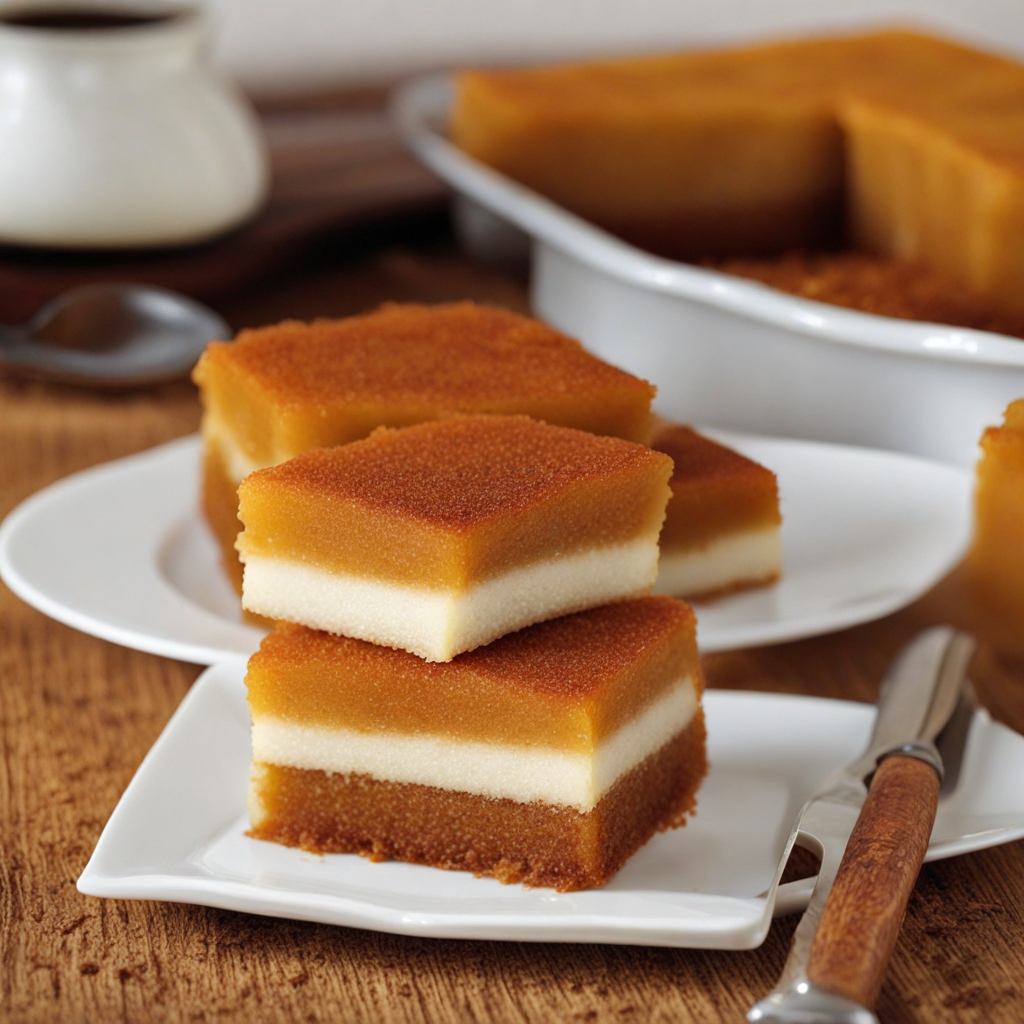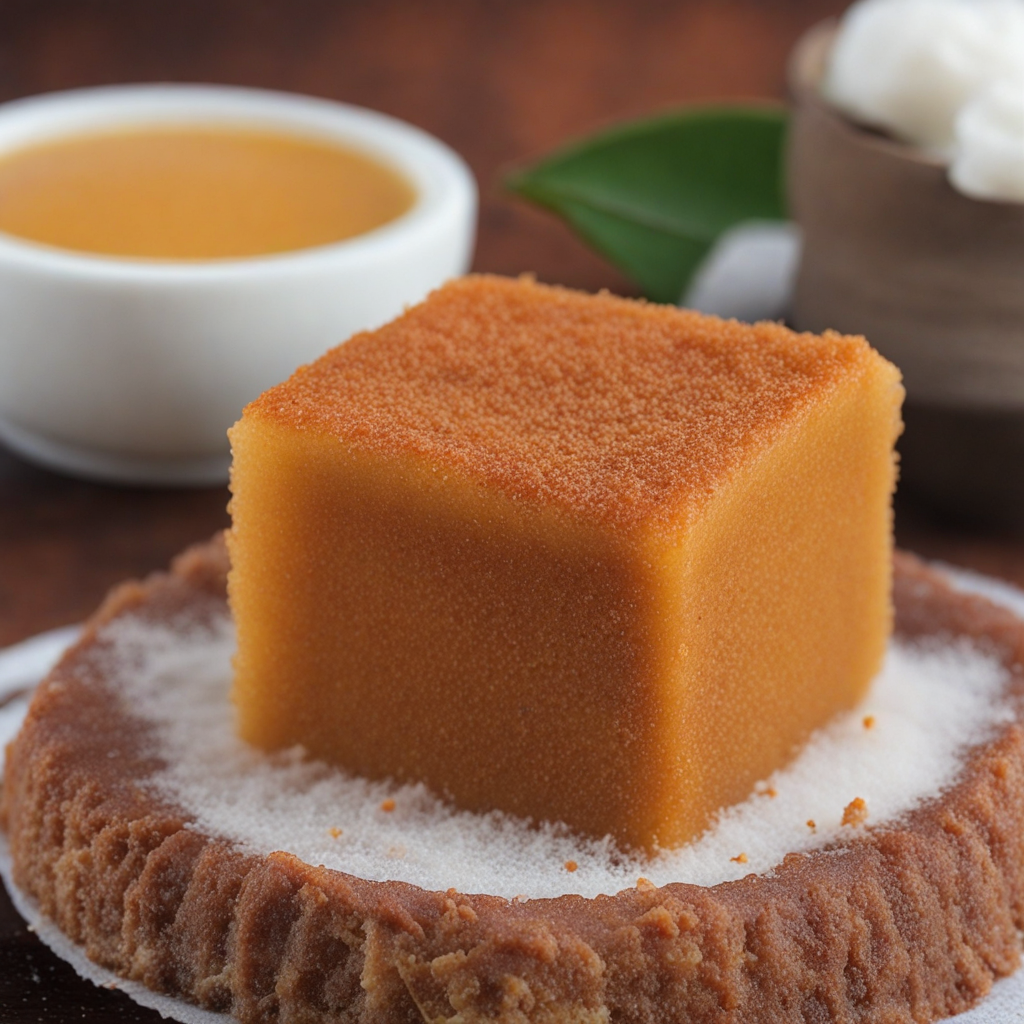Cassava Pone
Cassava Pone is a traditional Guyanese dessert that showcases the unique flavor and texture of cassava, a starchy root vegetable. This delightful dish is crafted by grating fresh cassava, which is then combined with a rich blend of ingredients like coconut milk, brown sugar, and spices such as nutmeg and cinnamon. The result is a dense, pudding-like treat that is both sweet and aromatic, offering a comforting taste that reflects the culinary heritage of Guyana. The use of freshly grated cassava gives the pone its distinctively moist and chewy texture, making each bite a satisfying experience. Cassava Pone is typically baked until it achieves a golden-brown crust, while the inside remains soft and flavorful. The infusion of coconut milk adds a creamy richness that perfectly complements the natural earthiness of the cassava. The combination of spices not only enhances the sweetness but also brings a warm, aromatic quality that is reminiscent of home-cooked comfort foods. Each bite is a celebration of the island’s agricultural bounty, with the cassava serving as a staple ingredient that has been enjoyed for generations. This dish is often served at special occasions, family gatherings, or as a delightful snack. It can be enjoyed warm or at room temperature, making it versatile for any time of the day. As you explore the flavors of Cassava Pone, you'll discover a taste that is deeply rooted in Guyanese culture, inviting you to savor the sweet, nutty, and slightly spiced notes that come together in this cherished dessert.
How It Became This Dish
Cassava Pone: A Sweet Slice of Guyanese Heritage Cassava pone is more than just a delicious dessert; it is a culinary relic deeply rooted in the history, culture, and traditions of Guyana. This delectable dish, characterized by its moist, dense texture and sweet flavor, embodies a fusion of indigenous practices, colonial influences, and the rich tapestry of the Caribbean's multicultural society. Tracing the origins, cultural significance, and evolution of cassava pone provides insight into its role as both a comfort food and a cultural symbol in Guyanese life. Origins of Cassava Cassava, scientifically known as Manihot esculenta, is a starchy root vegetable that is native to South America. It has been cultivated for thousands of years, with archaeological evidence suggesting its domestication by the indigenous peoples of the Amazon basin. As a drought-resistant crop, cassava thrived in the tropical climates of the Caribbean, making it an indispensable food source for the region's early inhabitants. Indigenous groups such as the Arawaks and Caribs utilized cassava in various forms, including flatbreads known as "cassava bread." This practice of processing cassava was essential, as the root contains cyanogenic compounds that are toxic if not properly prepared. The indigenous peoples developed techniques to detoxify cassava, including grating, soaking, and fermenting the root, which laid the groundwork for future culinary adaptations. The Arrival of European Influences With the arrival of European colonizers in the 15th and 16th centuries, cassava's role in the Caribbean diet expanded significantly. The Dutch, who settled in what is now Guyana in the 17th century, recognized the root's potential and began to cultivate it on a larger scale. As the British took control in the 18th century, cassava became integrated into the colonial economy, particularly in the context of the sugar plantations. Enslaved Africans, who were brought to the Caribbean to work in the sugar industry, adopted cassava into their diets, transforming it into various dishes, including cassava pone. Cassava pone itself has its roots in this period of cultural exchange. The dish is thought to have been influenced by African culinary practices, particularly the use of starchy ingredients to create dense, sweet desserts. The use of coconut, spices, and sometimes sweeteners like molasses or sugar reflects the diverse culinary traditions of the enslaved Africans, who blended their heritage with the resources available in their new environment. Cultural Significance Cassava pone is often associated with special occasions and communal gatherings in Guyana. It is a staple at celebrations, such as weddings, birthdays, and religious festivals, where it serves as both a dessert and a symbol of hospitality. Its preparation involves communal efforts, with families and friends coming together to grate cassava, mix ingredients, and bake the pone, reinforcing bonds and creating shared memories. The dish is also deeply tied to the concept of home and comfort. For many Guyanese, the taste of cassava pone evokes nostalgia, reminding them of family gatherings and the warmth of their childhood kitchens. It serves as a culinary link to their heritage, transcending generations and preserving the stories of their ancestors. Ingredients and Preparation The traditional recipe for cassava pone typically includes grated cassava, coconut, sugar, milk, and spices such as nutmeg or cinnamon. Some variations may include raisins or other dried fruits for added sweetness and texture. The process begins with the careful grating of the cassava, which is then combined with the other ingredients to form a thick batter. This mixture is poured into a greased baking dish and baked until it reaches a golden-brown hue. The versatility of cassava pone allows for regional variations, with different communities adding their unique touches. For instance, some may incorporate spices reflective of their cultural backgrounds, while others might experiment with different sweeteners or add-ins. This adaptability has allowed cassava pone to evolve over time, ensuring its continued relevance in modern Guyanese cuisine. Evolution Over Time As Guyana's demographics shifted throughout the 20th century, so too did the culinary landscape, including the preparation and consumption of cassava pone. The influx of Indian indentured laborers following the abolition of slavery introduced new flavors and ingredients, further enriching the diverse tapestry of Guyanese foodways. The blending of African, indigenous, Indian, and European influences is emblematic of the country's multicultural identity. Today, cassava pone remains a beloved treat, often found at local markets, bakeries, and restaurants. It is celebrated not only for its taste but also for its historical significance. In recent years, there has been a resurgence of interest in traditional Guyanese foods among younger generations, as people seek to reconnect with their roots and preserve their cultural heritage. This revival has led to a renewed appreciation for cassava pone, with many families passing down recipes and techniques to ensure that this cherished dish continues to be enjoyed. Conclusion In summary, cassava pone is a unique dish that encapsulates the complex history and cultural significance of Guyana. Its origins in the indigenous practices of cassava cultivation, the influences of colonialism and the African diaspora, and its evolution over time reflect the resilience and adaptability of the Guyanese people. As a beloved dessert served at gatherings and celebrations, cassava pone is more than just a food; it is a symbol of identity, community, and the enduring legacy of a rich culinary heritage. Today, it stands as a testament to the power of food to connect us to our past while continuing to nourish and bring joy in the present.
You may like
Discover local flavors from Guyana







